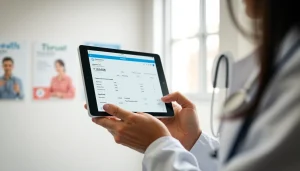Benefits and Implementation of Electronic Prescribing Systems for Enhanced Healthcare

Understanding Electronic Prescribing Systems
The Definition of Electronic Prescribing Systems
Electronic prescribing systems, often abbreviated as e-prescribing, are digital applications that allow healthcare providers to generate and transmit prescriptions electronically. These systems facilitate the entire process, eliminating the traditional reliance on handwritten prescriptions, which can often lead to miscommunication and errors. Through these systems, prescribers can send accurate, clear, and actionable prescriptions directly to pharmacies, thereby enhancing efficiency and safety in medication management. According to various studies, the utilization of electronic prescribing systems has gained traction across the healthcare industry for their capacity to improve the workflow and outcomes in patient care.
How Electronic Prescribing Systems Work
Electronic prescribing systems work by integrating with a provider’s electronic health record (EHR) systems to streamline the prescription process. When a healthcare provider decides to prescribe a medication, they enter the details into the e-prescribing software. This software typically includes a vast database of medications, allergies, and potential drug interactions, ensuring that prescriptions are safe and appropriate. Once the prescription is completed, it is transmitted electronically to the specified pharmacy, eliminating traditional issues such as lost prescriptions or misinterpretations caused by illegible handwriting.
Key Benefits of Using Electronic Prescribing Systems
The advantages of electronic prescribing systems extend beyond mere convenience. They are instrumental in reducing medication errors, improving prescription accuracy, enhancing communication between healthcare providers and pharmacies, and ultimately ensuring better patient outcomes. E-prescribing systems are equipped with safety features such as alerts for potential drug interactions or allergies, as well as reminders for medication refills. These capabilities not only streamline the prescription process but also contribute to a more comprehensive approach to patient care.
Advantages of Electronic Prescribing Systems
Improving Prescription Accuracy
One of the most significant advantages of electronic prescribing systems is their ability to improve prescription accuracy. By providing an electronic template for medications, dosages, and administration instructions, these systems minimize the risk of errors that may occur with handwritten prescriptions. Studies indicate that e-prescribing reduces the incidence of adverse drug events due to miscommunication, making it a vital tool for enhancing patient safety.
Streamlining Communication Between Providers
Effective communication is crucial in the healthcare sector, and electronic prescribing systems enhance this by enabling seamless interaction among healthcare providers. When all prescription details are recorded and transmitted through a unified system, providers can communicate more effectively about a patient’s treatment plan. This not only fosters collaborative care but also allows for quicker decision-making regarding medication management.
Enhancing Patient Safety and Compliance
E-prescribing enhances patient safety by ensuring that patients receive correct dosages and appropriate medications. The safety features embedded in these systems alert providers about potential prescription problems, such as contraindications or duplicate therapies, promoting adherence to safety standards. Moreover, patients benefit from improved compliance, as they are less likely to experience misunderstandings regarding their prescriptions, making it easier for them to follow their treatment protocols correctly.
Implementation Strategies for Electronic Prescribing Systems
Steps to Implement Electronic Prescribing Systems
Successfully implementing electronic prescribing systems within a healthcare setting requires a strategic approach. The first step involves selecting a suitable e-prescribing software that meets the specific needs and regulatory requirements of the institution. Following software selection, the next step includes integrating the system with existing EHRs to ensure data interoperability and a seamless transition. Developing a comprehensive implementation timeline and checklist can facilitate a structured rollout, minimizing disruptions to daily operations.
Training and Support for Healthcare Personnel
Training is a crucial aspect of implementing electronic prescribing systems, as healthcare personnel must understand how to use the technology effectively. Comprehensive training sessions should be conducted to cover the functionalities of the e-prescribing system, including how to manage prescriptions, access patient records, and utilize safety features. Offering ongoing support, such as access to helpdesk resources or regular refreshers, can further enhance proficiency among staff.
Assessing System Integration with Existing Workflows
To maximize the effectiveness of electronic prescribing systems, it is essential to assess how these systems will integrate with existing clinical workflows. This involves analyzing current processes and identifying points where e-prescribing can enhance efficiency. Engaging stakeholders, including pharmacists and healthcare providers, in this analysis can provide insights into potential challenges and improvements, ensuring a smooth transition to electronic prescribing.
Challenges in Adopting Electronic Prescribing Systems
Common Barriers to Adoption
Despite the myriad benefits of electronic prescribing systems, several barriers can hinder their adoption. Common challenges include resistance from healthcare professionals who may be accustomed to traditional prescribing methods, concerns about the initial costs of implementation, and the complexity of integrating new technology with existing systems. Addressing these barriers requires effective change management strategies that help mitigate concerns and emphasize the long-term advantages of transitioning to an electronic system.
Addressing Security and Privacy Concerns
Security and privacy are paramount when implementing electronic prescribing systems, given the sensitive nature of patient information. Ensuring compliance with regulations such as the Health Insurance Portability and Accountability Act (HIPAA) is crucial for protecting patient data. Healthcare organizations must implement robust security measures, including data encryption, user authentication, and regular audits, to safeguard confidential information while maintaining the trust of patients.
Managing the Transition from Paper to Digital
The transition from paper-based to electronic prescribing systems can be a daunting task for many healthcare organizations. This shift requires not only technological changes but also cultural adaptation among staff. Providing adequate resources, including time for adjusting to the new system and opportunities for feedback, helps ease this transition. Creating a phased approach to technology adoption can also provide staff with the necessary support as they become comfortable with the new processes.
Future Trends in Electronic Prescribing Systems
Emerging Technologies and Innovations
The future of electronic prescribing systems is poised for transformation as emerging technologies reshape the healthcare landscape. Advancements in mobile applications, cloud-based solutions, and integration with telehealth platforms are some of the innovations enhancing the e-prescribing experience. As technology evolves, these systems will likely become more user-friendly and flexible, accommodating the diverse needs of healthcare providers and patients alike.
The Role of Artificial Intelligence in Electronic Prescribing Systems
Artificial intelligence (AI) is expected to play an increasingly significant role in electronic prescribing systems. AI algorithms can analyze vast amounts of data, enabling predictive analytics that enhance clinical decision-making. For instance, AI can help in identifying patients at risk of non-compliance or flagging prescriptions that may interact adversely with other medications. This level of sophistication can further elevate the effectiveness and safety of electronic prescriptions.
Predictions for the Future of Electronic Prescribing Systems
Looking ahead, electronic prescribing systems are likely to become more integrated within wider health information exchanges, allowing for seamless sharing of patient data across various platforms and providers. Enhanced customization features, tailored alerts, and improved interfaces will drive user engagement and satisfaction. As regulatory frameworks evolve, adoption rates of electronic prescribing systems are expected to climb, making them an indispensable component of modern healthcare delivery.




